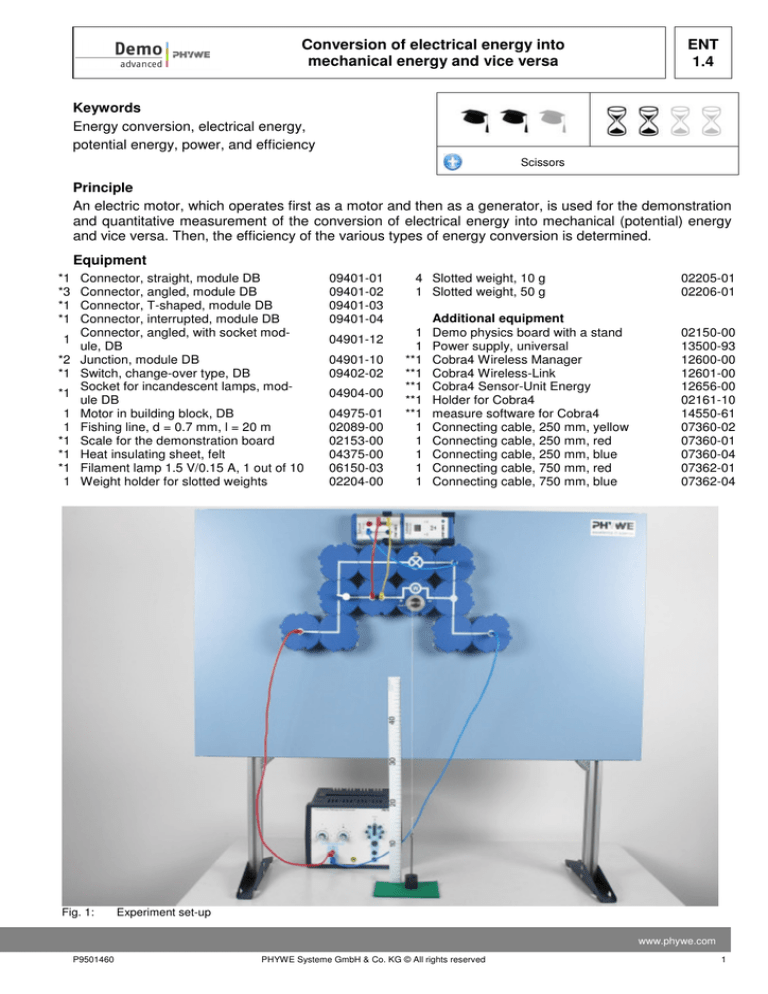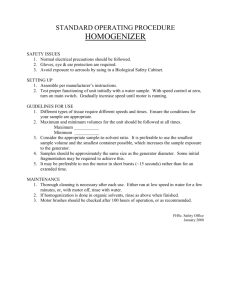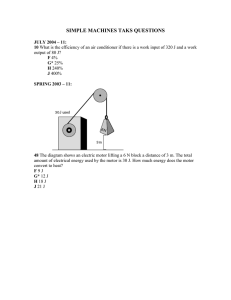
Conversion of electrical energy into
mechanical energy and vice versa
ENT
1.4
Keywords
Energy conversion, electrical energy,
potential energy, power, and efficiency
Scissors
Principle
An electric motor, which operates first as a motor and then as a generator, is used for the demonstration
and quantitative measurement of the conversion of electrical energy into mechanical (potential) energy
and vice versa. Then, the efficiency of the various types of energy conversion is determined.
Equipment
*1
*3
*1
*1
1
*2
*1
*1
1
1
*1
*1
*1
1
Connector, straight, module DB
Connector, angled, module DB
Connector, T-shaped, module DB
Connector, interrupted, module DB
Connector, angled, with socket module, DB
Junction, module DB
Switch, change-over type, DB
Socket for incandescent lamps, module DB
Motor in building block, DB
Fishing line, d = 0.7 mm, l = 20 m
Scale for the demonstration board
Heat insulating sheet, felt
Filament lamp 1.5 V/0.15 A, 1 out of 10
Weight holder for slotted weights
Fig. 1:
09401-01
09401-02
09401-03
09401-04
04901-12
04901-10
09402-02
04904-00
04975-01
02089-00
02153-00
04375-00
06150-03
02204-00
4 Slotted weight, 10 g
1 Slotted weight, 50 g
1
1
**1
**1
**1
**1
**1
1
1
1
1
1
Additional equipment
Demo physics board with a stand
Power supply, universal
Cobra4 Wireless Manager
Cobra4 Wireless-Link
Cobra4 Sensor-Unit Energy
Holder for Cobra4
measure software for Cobra4
Connecting cable, 250 mm, yellow
Connecting cable, 250 mm, red
Connecting cable, 250 mm, blue
Connecting cable, 750 mm, red
Connecting cable, 750 mm, blue
02205-01
02206-01
02150-00
13500-93
12600-00
12601-00
12656-00
02161-10
14550-61
07360-02
07360-01
07360-04
07362-01
07362-04
Experiment set-up
www.phywe.com
P9501460
PHYWE Systeme GmbH & Co. KG © All rights reserved
1
ENT
1.4
Conversion of electrical energy into
mechanical energy and vice versa
1 Scissors
1 PC, USB port, XP, Vista, Win7
* Included in the ENT 1 set
** Included in the Cobra4 extension set
09492-88
12608-88
Notes
During the first experiment, we recommend guiding the object (weight holder with slotted weights) slowly
downwards by hand in order to generate as little electrical energy as possible.
During the second experiment, it must be ensured that the fishing line is wound properly on the pulley of
the generator.
The first two experiment parts are averaged for reasons of error minimisation.
The third experiment helps to establish a direct connection between the two individual measurements.
Grabbing the object after it has been lifted ensures that the measurements can be separated more
clearly from each other.
Due to the height of the weight holder of 13 cm and the safety distance of 5 cm, the drop height of 50 cm
results in a total height of the motor of 68 cm.
During these experiments, only 4 V are applied to the motor since, otherwise, the weight holder would be
lifted too fast. As a result, the 12 V motor only operates with low efficiency.
Set-up
Build a circuit on the board with the aid of the various modules as shown in Fig. 1. The switch closes
the circuit of the light bulb. The pulley of the motor should be located 68 cm above the tabletop. Position the scale vertically on the table so that it is aimed upwards at the motor.
Fasten the fishing line to the pulley of the motor. Wind a sufficient amount of fishing line around the
pulley so that the groove is filled. Guide the fishing line from the reel down to the table and cut it off.
Place the slotted weights onto the weight holder (total weight of the object = 100 g), hook the weight
holder into the fishing line, and place it down onto the tabletop.
Connect the DC voltage output of the power supply unit to the circuit (Fig. 1) and adjust a voltage of
4 V-.
Connect the Cobra4 Sensor-Unit Energy to the circuit as shown in Fig. 1. Ensure that the A socket
of the Sensor-Unit is used.
Place the felt sheet on the table so that the table is protected against damage when the weight
holder falls down.
Procedure
Start the PC and Windows.
Connect the Cobra4 Wireless-Manager to the USB port of the PC.
Start the "measure" software package on the PC.
Connect the Cobra4 Wireless-Link to the Cobra4 Sensor-Unit Energy. After the Wireless-Links have
been switched on, the Sensor-Units will be automatically detected and assigned an ID number that
will be displayed on the displays of the two Cobra4 Wireless-Links. The communication between the
Cobra4 Wireless-Manager and the Cobra4 Wireless-Links is indicated by way of the respective data
LED.
Switch the Cobra4 Wireless-Link with the connected Cobra4 Sensor-Unit on. The Sensor-Unit and
the electrical quantities U, I, P, and W are displayed as the measuring channels.
2
PHYWE Systeme GmbH & Co. KG © All rights reserved
P9501460
Conversion of electrical energy into
mechanical energy and vice versa
ENT
1.4
1st experiment: motor
Load the experiment "Motor" (Experiment > Open experiment > …). The program will now open all
of the required presettings for the measurement data recording process (Fig. 2).
Switch the power supply unit on.
Start the measurement data recording process in "measure" .
When the lower edge of the weight holder with the slotted weights has been pulled up to 50 cm, flip
the switch and, at the same time, grab the weight holder.
Guide the weight holder with the slotted weights slowly and, by hand, back down onto the table.
Repeat the measurement twice.
Stop the measurement data recording process in "measure" .
Switch the power supply unit off.
Transfer the measurement values to the "measure" main program.
Fig. 2:
Measurement data recording process for experiment 1
www.phywe.com
P9501460
PHYWE Systeme GmbH & Co. KG © All rights reserved
3
ENT
1.4
Conversion of electrical energy into
mechanical energy and vice versa
2nd experiment: generator
Load the experiment "Generator" (Experiment > Open experiment > …). The program will now open
all of the required presettings for the measurement data recording process (Fig. 3).
Set the switch to the position in which the lamp circuit is closed.
Wind the fishing line onto the pulley so that the lower edge of the weight holder with the slotted
weights is located 50 cm above the table.
Start the measurement data recording process in "measure" .
Release the weight holder with the slotted weights.
Wind the fishing line slowly up while holding the motor pulley.
Repeat the measurement twice.
Stop the measurement data recording process in "measure" .
Transfer the measurement values to the "measure" main program.
Fig. 3:
4
Measurement data recording process for experiment 2
PHYWE Systeme GmbH & Co. KG © All rights reserved
P9501460
Conversion of electrical energy into
mechanical energy and vice versa
ENT
1.4
3rd experiment: motor - generator
Load the experiment "Motor" (Experiment > Open experiment > …). The program will now open all
of the required presettings for the measurement data recording process (Fig. 4).
Set the switch to the position in which the lamp circuit is closed.
Switch the power supply unit on.
Start the measurement data recording process in "measure" .
When the lower edge of the weight holder with the slotted weights has been pulled up to 50 cm, flip
the switch and, at the same time, grab the weight holder.
Flip the switch again so that the lamp circuit is closed and wait briefly. Release the weight holder after a few seconds.
Flip the switch again and repeat the measurement twice.
Stop the measurement data recording process in "measure" .
Switch the power supply unit off.
Transfer the measurement values to the "measure" main program.
Fig. 4:
Measurement data recording process for experiment 3
Observations and results
The motor lifts the weight holder with the slotted weights up. During the downward movement, the light
bulb emits light.
www.phywe.com
P9501460
PHYWE Systeme GmbH & Co. KG © All rights reserved
5
ENT
1.4
Conversion of electrical energy into
mechanical energy and vice versa
Evaluation
The motor requires electrical energy for lifting the object. With the aid of a motor, electrical energy can
be converted into mechanical energy. As the lighting of the light bulb proves, a generator can convert
mechanical energy into electrical energy.
During these processes, heat is produced due to the friction in the motor and also due to the fact that the
coils inside the motor heat up. This is why the efficiency is partly a lot lower than 100%.
The Cobra4 Sensor-Unit Energy measures not only the voltage U and the current I of the motor or generator, but also the power P and the electric work W.
1st experiment: motor
In order to calculate the efficiency of the motor, first the required electrical energy Eel1 per lifting process
must be calculated.
The function "Survey"
can be used to determine the total energy for the three lifting processes based
on the measurement curve.
In addition, the mechanical (potential) energy can be calculated as follows:
Emech = Epot = m . g . h = 0.1 kg . 9.81 ms-2 . 0.5 m
Emech = 0.49 Nm = 0.49 Ws.
Energy for the three lifting
processes in Ws
Energy Eel1 per lifting process
in Ws
Mechanical energy in Ws
10.58
3.52
0.49
Based on these values, the efficiency can be calculated:
η1 = Emech : Eel1 = 0.49 Ws : 3.52 Ws
η1 = 13.9 %.
Fig. 5:
6
Measurement for experiment 1
PHYWE Systeme GmbH & Co. KG © All rights reserved
P9501460
Conversion of electrical energy into
mechanical energy and vice versa
ENT
1.4
2nd experiment: generator
The calculation of the efficiency of the generator requires the electrical energy Eel2 that is generated per
dropping process.
The function "Survey"
can be used to determine the total energy for the three dropping processes
based on the measurement curve.
The potential energy is the same as during the first experiment.
Energy for the three dropping
processes in Ws
Energy Eel2 per dropping
process in Ws
Mechanical energy in Ws
0.72
0.24
0.49
Based on these values, the efficiency can be calculated:
η2 = Eel2 : Emech = 0.24 Ws : 0.49 Ws
η2 = 49 %.
Now, it is theoretically possible to calculate the total efficiency for lifting and dropping the object.
ηtotal = η1 . η2 = 13.9% . 49%
ηtotal = 6.8%
Fig. 6:
Measurement for experiment 2
www.phywe.com
P9501460
PHYWE Systeme GmbH & Co. KG © All rights reserved
7
ENT
1.4
Conversion of electrical energy into
mechanical energy and vice versa
3rd experiment: motor - generator
The aim of this part of the experiment is to provide a quantitative view. It shows that lifting the object requires more energy than is generated when the object drops down. However, the conversion of mechanical energy into electrical energy can be observed rather well.
Fig. 7:
Measurement for experiment 3
Application
The conversion of energy plays an important role in numerous areas of life, e.g. the conversion of electrical energy into mechanical energy in the household or the conversion of mechanical energy into electrical energy in power plants. It becomes clear that each of these types of conversion has only a certain
efficiency and that every conversion also generates losses.
The experiment "Motor - Generator" is used for the illustration of a pumped storage hydropower plant,
since electrical energy can be stored as mechanical energy and reconverted into electrical energy as required.
For the execution of the experiment without a PC, the items on the list (page 1)
that are marked with (**) must be replaced with the following items:
Experiment P9501363
1
1
1
1
1
Cobra4 Mobile-Link
Cobra4 Display-Connect, transmitter and receiver set
Holder for hand-held meters
Large-scale display
Cobra4 Sensor-Unit Energy
12620-00
12623-88
02161-00
07157-93
12656-00
Experiment P9501300
1 Work and power meter
8
13715-93
PHYWE Systeme GmbH & Co. KG © All rights reserved
P9501460






